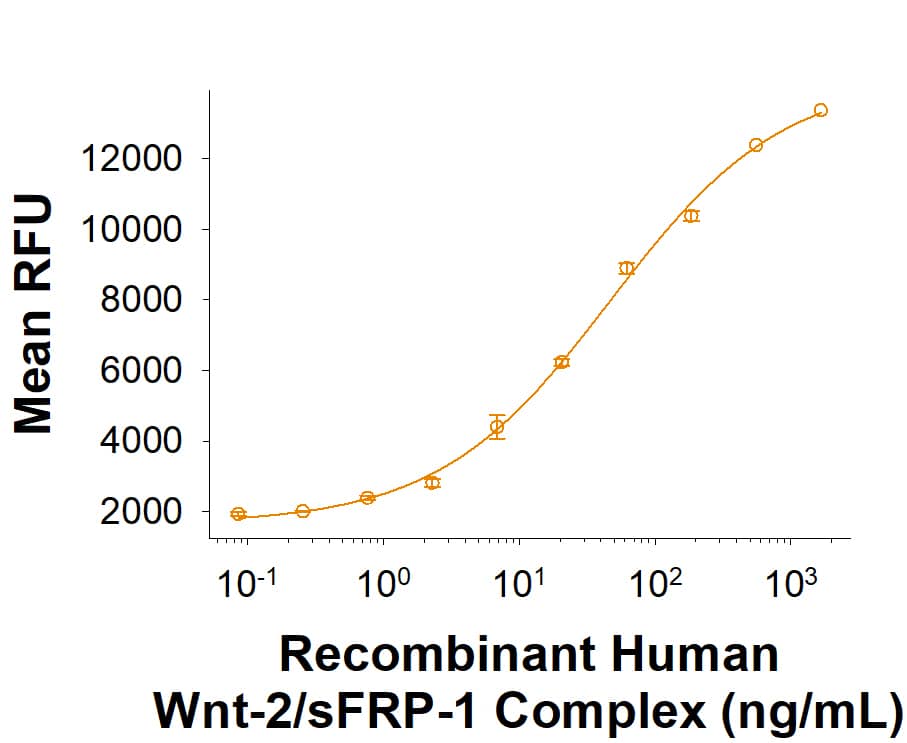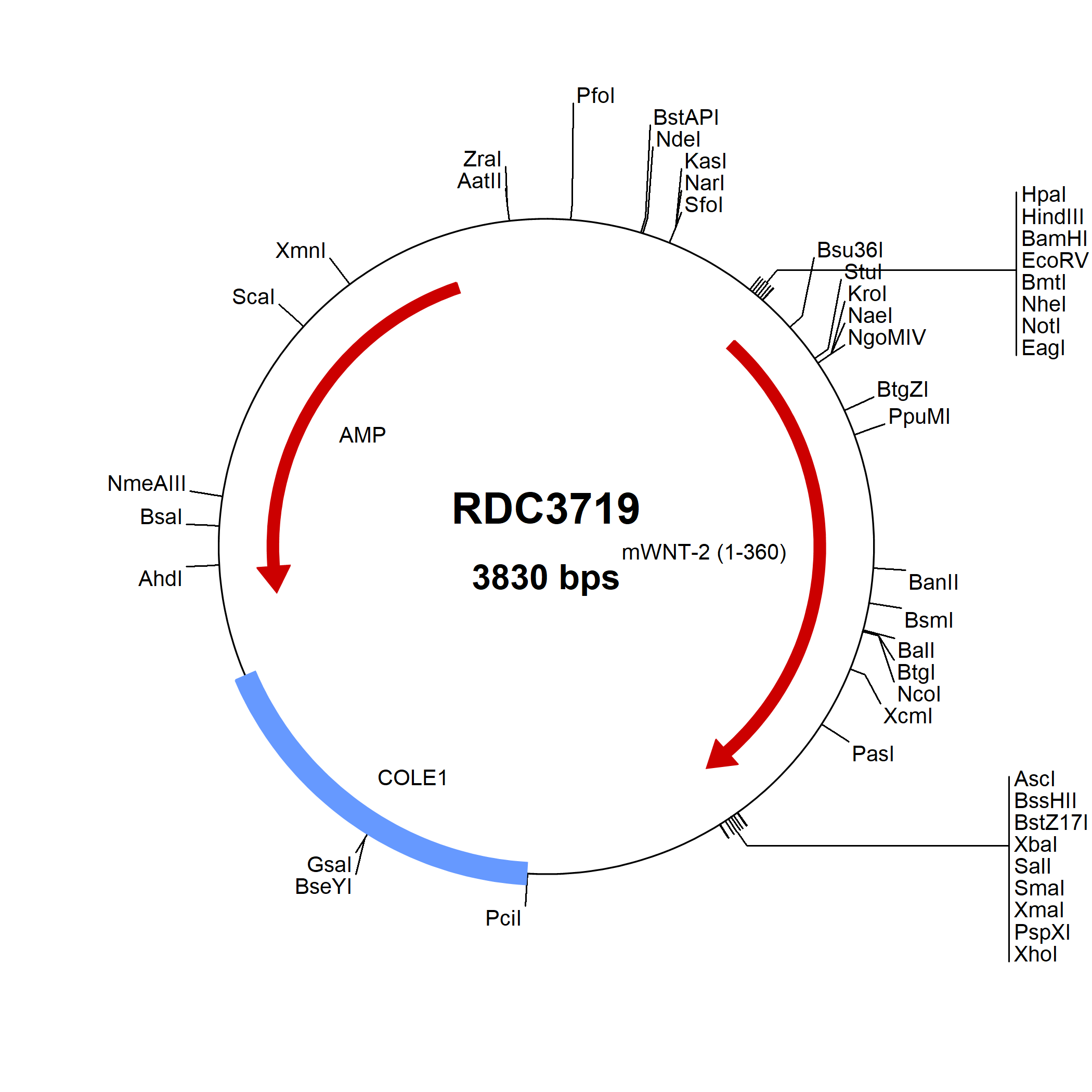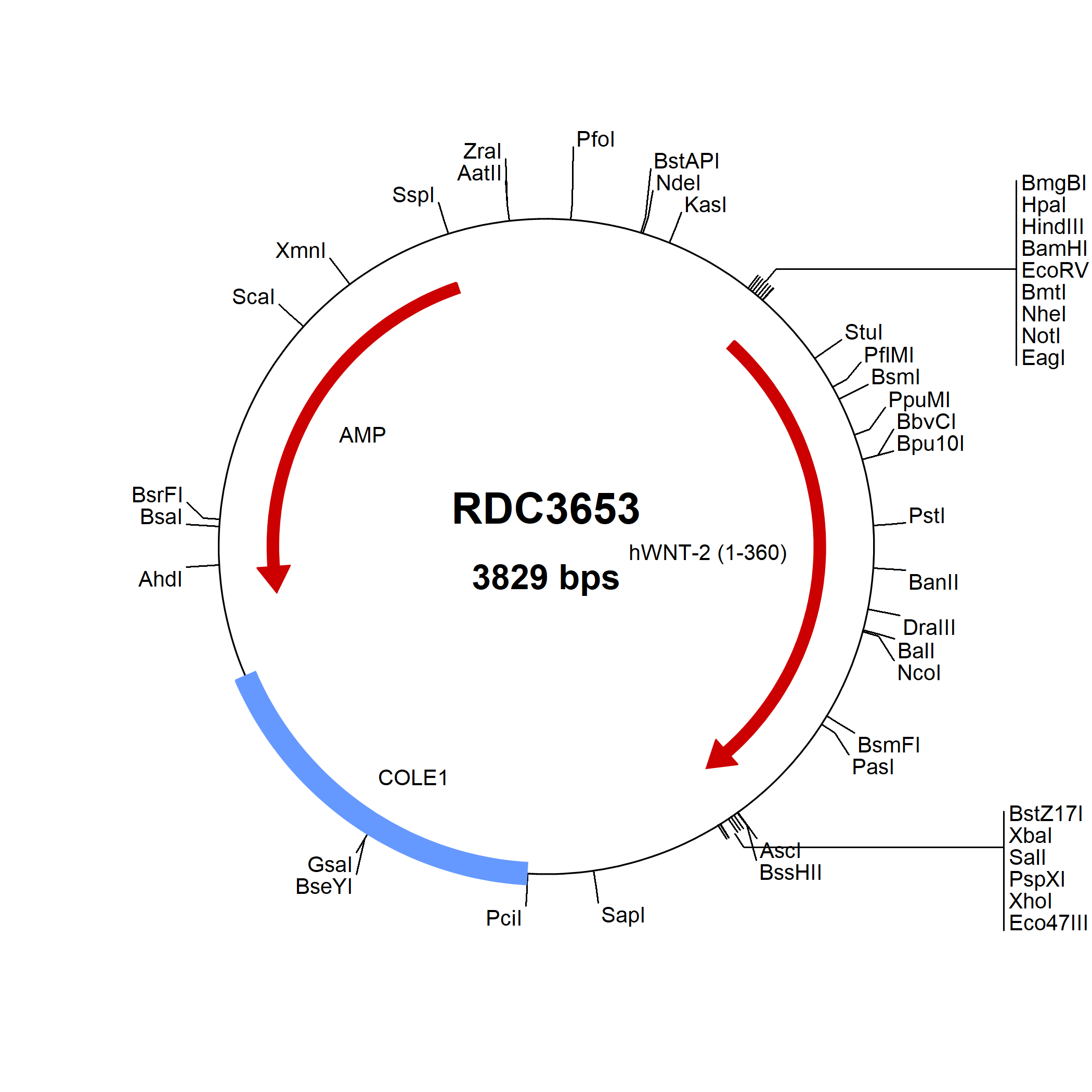Wnt-2 Products
Wnt-2 is a secreted, glycosylated member of the Wnt family of developmental proteins. It is considered a class 1 Wnt based on its strong transforming activity on C57MG cells. Wnt-2 is produced by mammary myoepithelial cells, endometrial epithelial cells and breast fibroblasts. Increased expression of Wnt-2 has been implicated in colorectal cancer pathology. Wnt-2 has also been shown to be involved in dynamic remodeling of the dendritic architecture, inducing dendritic aborization in a CREB dependent manner. Human Wnt-2 is synthesized as a 360 amino acid (aa) precursor that contains a 335 aa mature region. The mature region contains 24 cysteines and two potential N-linked glycosylation sites. Mature human Wnt-2 is 96% aa identical to mature mouse and rat Wnt-2.
The Wnts make up a large family of secreted proteins with roles in pattern formation, cell fate decision, axon guidance, and tumor formation. Wnt family members vary in length between 350 and 400 aa, possess 22 to 24 conserved cysteines, are highly hydrophobic, and show 20 - 85% aa identity within the Wnt family. In general, there are three signaling pathways associated with Wnt-receptor interaction. The first is commonly called the canonical pathway and ultimately culminates in beta-Catenin accumulation and TCF/LEF-1-mediated gene transcription. The other two less well-defined non-canonical pathways include the Wnt/Ca2+ pathway and the planar cell polarity (PCP) pathway.
31 results for "Wnt-2" in Products
31 results for "Wnt-2" in Products
Wnt-2 Products
Wnt-2 is a secreted, glycosylated member of the Wnt family of developmental proteins. It is considered a class 1 Wnt based on its strong transforming activity on C57MG cells. Wnt-2 is produced by mammary myoepithelial cells, endometrial epithelial cells and breast fibroblasts. Increased expression of Wnt-2 has been implicated in colorectal cancer pathology. Wnt-2 has also been shown to be involved in dynamic remodeling of the dendritic architecture, inducing dendritic aborization in a CREB dependent manner. Human Wnt-2 is synthesized as a 360 amino acid (aa) precursor that contains a 335 aa mature region. The mature region contains 24 cysteines and two potential N-linked glycosylation sites. Mature human Wnt-2 is 96% aa identical to mature mouse and rat Wnt-2.
The Wnts make up a large family of secreted proteins with roles in pattern formation, cell fate decision, axon guidance, and tumor formation. Wnt family members vary in length between 350 and 400 aa, possess 22 to 24 conserved cysteines, are highly hydrophobic, and show 20 - 85% aa identity within the Wnt family. In general, there are three signaling pathways associated with Wnt-receptor interaction. The first is commonly called the canonical pathway and ultimately culminates in beta-Catenin accumulation and TCF/LEF-1-mediated gene transcription. The other two less well-defined non-canonical pathways include the Wnt/Ca2+ pathway and the planar cell polarity (PCP) pathway.
| Source: | CHO |
| Applications: | BA |
| Reactivity: | Human |
| Details: | Goat IgG Polyclonal |
| Applications: | WB, IHC |
| Reactivity: | Human, Mouse, Rat |
| Details: | Rabbit IgG Polyclonal |
| Applications: | IHC, WB |
Recombinant Monoclonal Antibody
| Reactivity: | Human, Mouse, Rat |
| Details: | Rabbit IgG Monoclonal Clone #SR1571 |
| Applications: | WB |
| Reactivity: | Human |
| Details: | Rabbit IgG Polyclonal |
| Applications: | WB |
| Reactivity: | Mouse |
| Details: | Rabbit IgG Polyclonal |
| Applications: | WB |
| Reactivity: | Human |
| Details: | Rabbit IgG Polyclonal |
| Applications: | WB |
| Reactivity: | Human |
| Details: | Rabbit IgG Polyclonal |
| Applications: | WB |
| Reactivity: | Human |
| Details: | Rabbit IgG Polyclonal |
| Applications: | WB |
| Reactivity: | Human |
| Details: | Rabbit IgG Polyclonal |
| Applications: | WB |
| Reactivity: | Human |
| Details: | Rabbit IgG Polyclonal |
| Applications: | WB |
| Reactivity: | Human |
| Details: | Rabbit IgG Polyclonal |
| Applications: | WB |
| Reactivity: | Human |
| Details: | Rabbit IgG Polyclonal |
| Applications: | WB |
| Reactivity: | Human |
| Details: | Rabbit IgG Polyclonal |
| Applications: | WB |
| Reactivity: | Human |
| Details: | Rabbit IgG Polyclonal |
| Applications: | WB |
| Reactivity: | Human |
| Details: | Rabbit IgG Polyclonal |
| Applications: | WB |
| Reactivity: | Human |
| Details: | Rabbit IgG Polyclonal |
| Applications: | WB |
| Reactivity: | Human |
| Details: | Rabbit IgG Polyclonal |
| Applications: | WB |
| Reactivity: | Human |
| Details: | Rabbit IgG Polyclonal |
| Applications: | WB |
| Reactivity: | Human |
| Details: | Rabbit IgG Polyclonal |
| Applications: | WB |
| Reactivity: | Human |
| Details: | Rabbit IgG Polyclonal |
| Applications: | WB |
| Reactivity: | Human |
| Details: | Rabbit IgG Polyclonal |
| Applications: | WB |
| Reactivity: | Human |
| Details: | Rabbit IgG Polyclonal |
| Applications: | WB |






![Western Blot: Wnt-2 Antibody [NBP2-94468] - Wnt-2 Antibody - BSA Free](https://resources.bio-techne.com/images/products/nbp2-94468_rabbit-polyclonal-wnt-2-antibody-immunohistochemistry-paraffin-145202413540..jpg)
![Western Blot: Wnt-2 Antibody (SR1571) [NBP3-21653] -](https://resources.bio-techne.com/images/products/nbp3-21653_rabbit-wnt-2-mab-sr1571-57202315584836.jpg)
![Western Blot: Wnt-2 Antibody [NBP1-57938] Western Blot: Wnt-2 Antibody [NBP1-57938]](https://resources.bio-techne.com/images/products/Wnt-2-Antibody-Western-Blot-NBP1-57938-img0003.jpg)
![Western Blot: Wnt-2 Antibody [NBP1-98349] Western Blot: Wnt-2 Antibody [NBP1-98349]](https://resources.bio-techne.com/images/products/Wnt-2-Antibody-Western-Blot-NBP1-98349-img0002.jpg)
![Western Blot: Wnt-2 Antibody [NBP3-06123] Western Blot: Wnt-2 Antibody [NBP3-06123]](https://resources.bio-techne.com/images/products/Wnt-2-Antibody-Western-Blot-NBP3-06123-img0001.jpg)
